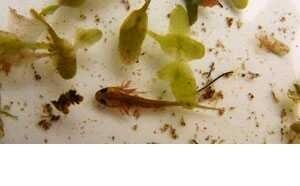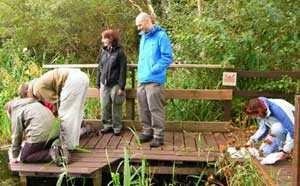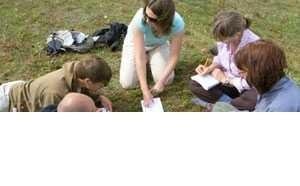WILDLIFE ECOLOGICAL SURVEY
Ecological survey refers to the gathering of information about flora and fauna species composition in a given area or range land. The process of examining or studying wildlife component.


Ecological survey of a pond

Vegetation survey
Factors to be Considered When Carrying out Ecological Survey
i)Topography
ii)Weather
iii)Timing
iv)Animal species
v)Human interference
Objectives of Carrying Out Ecological Survey
i)To determine the abundance or density of species present in an area
ii)To monitor seasonal changes in species composition and number
iii)To determine the total number of plant and animal species in the area
Methods of Carrying Out Ecological Survey
i) Sample plot: this is one of the methods of carrying out ecological survey. The sample plot could be 100m×100m depending on what you want to assess.
ii) Transect count: this is done by making a line and carefully walking on transect and making observations.
iii) Point centre quadrat (PCQ): this method is used in assessing micro plants.
iv) Distant sampling: in this survey, the distance from where an animal is sighted is measured and calculated and the number of animals sighted is also taken down.
iv) Point count assessment: in this, the surveyor stands at a certain point checks round, that is, three hundred and sixty away and counts the number of animals sighted
v) Mark and re-capture method: here the surveyor captures an animal, marks and releases it and then re-captures it again. It is used to know the population of animals especially rodents.
Equipment Used In Carrying Out Ecological Survey
i) Quadrat
ii) Wrist watch
iii) One meter measuring stick
iv)A precise distance of 10 meters
v)Camera
vi)Writing materials
v) Measuring tape
Research Data Collection
Research is a careful studies or investigation carried out on something or object at a particular time in a particular place in order to discover new facts.
Data is an unprocessed facts, observation or information used in deciding or discussing something.
Therefore, research data collection: Is the process of gathering and measuring information on variables of interest, in an established systematic fashion that enables one to answer stated research questions, test hypothesis and outcomes.
Types of Research
i)Ecological research
ii)Sociological research
iii)Laboratory research
iv)Field research
i. Ecological Research: is a type of research where the researcher tries to find out how ecosystem is function. He seeks to investigate the inter-relationship and inter-dependence between flora, fauna resources and their environment.
ii. Sociological Research: is a type of research that has to do with the effective, functioning, structure and development of human society. The interviewer seeks to investigate the rate of existence of societal problems base on interrelationship and interdependence in its immediate environment.
The interviewer uses a method called questionnaire.
Types of Questionnaire
Structural questionnaire
Non-structural
Structural Questionnaire: consist of bio data that is name, place of origin, etc. and it is design in optional manner from A-D and the respondent only has to select the suitable answer.
Non-Structural Questionnaire: is design in a subjective manner where the respondent provides answers for the interviewer.
iii) Laboratory Research: this is the type of research that is conducted in a room or building that is well equipped for scientific experimentation. The researcher seeks to investigate the naturally occurring behavior under controlled conditions with manipulated variables.
iv) Field Research: this is a type of research that is carried out outside the laboratory. The researchers collect the primary or first-hand information through the following ways:
-Face –face interview
-Direct observation
-Postal survey.
-Telephone survey.
Characteristics of Research
i)It aims at solving problems
ii) it is conducted in a systematic and objective manner
Research is based on accurate observable experience and description
Research emphasizes the development of general principles of theories that would help in predicting future occurrences
Types of Data
In the context of research data collection, various data may be collected;
i)Data of human activities: this may include gun shot, empty carriages, snares or traps, human entreats, logging, human traits, farming, abandoned human objects etc.
ii)Data of animal activities: such as foot prints, feeding activities, droppings, feathers, bones, carcasses, animal calls, trails, nests, etc At this stage of data collection, organization analysis and generalization of data are needed for the proper articulation and understanding of the problem of conservation or protection before seeking for solution to the problem. The formulation of possible results to this problem of protection or conservation and its possible to answers referred to as hypothesis. This method of research is referred to as developmental research as it involves the investigation of patterns and sequence of growth or changes that take place as a function of time.
Methods of Research Data Collection
i)Audio/visual data collection through TV, internet services, computers, radios etc.
ii)Habitat mappings
iii)interview, questioning and discussion
iv)Field observation- direct and indirect observation.
v)Indirect observation: feathers, footprint, nest, skull, feeding, egg shell etc.
vi)Direct observation: observations obtained from physical siting of the animals
vii) Textbooks, newspapers, maps, magazines, pamphlet etc
viii)camera trapping, aerial photograph, satellite imagery, and remote sensing
Choice of methods would depend on the data required and objectives of the study.
"Data Forms*
The information collection during each sensor is recorded in data sheet. The data sheet contains columns for option formation from distant to observation and density estimation.
Data Entry
Data entry should be entered on data sheet to first confirm the number of specie and individual observed, data should then be entered on a paper copy from the line transect including the distant information if collected.
Data Analysis
The data is presented as relative abundant date for array. The sensor methology is consistence for all site array for comparison of local regional different in relative abundant indices.
Congratulations! This post has been upvoted from the communal account, @minnowsupport, by simaoatb from the Minnow Support Project. It's a witness project run by aggroed, ausbitbank, teamsteem, theprophet0, someguy123, neoxian, followbtcnews, and netuoso. The goal is to help Steemit grow by supporting Minnows. Please find us at the Peace, Abundance, and Liberty Network (PALnet) Discord Channel. It's a completely public and open space to all members of the Steemit community who voluntarily choose to be there.
If you would like to delegate to the Minnow Support Project you can do so by clicking on the following links: 50SP, 100SP, 250SP, 500SP, 1000SP, 5000SP.
Be sure to leave at least 50SP undelegated on your account.